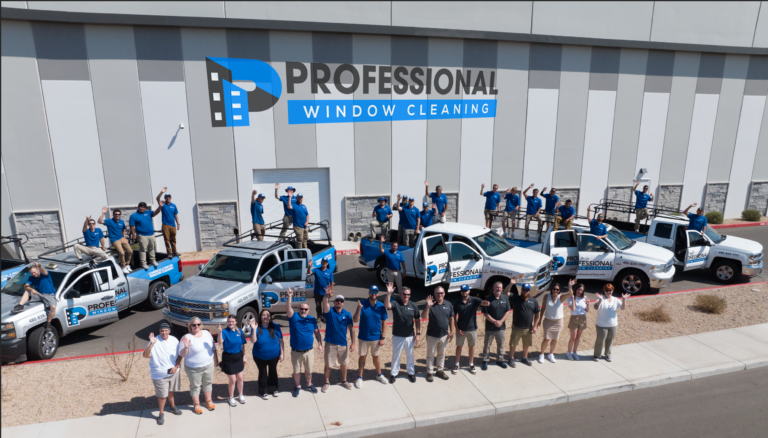Drones are no longer just a hobbyist’s plaything – they are rapidly becoming an essential tool in various industries, including high rise window cleaning.
We will explore the different types of drones and their uses, as well as the challenges faced in high rise window cleaning. Discover how drones are revolutionizing this industry by providing increased safety for workers, faster cleaning processes, and the ability to reach challenging areas.
Join us as we delve into the future possibilities for drones in high rise window cleaning.
What Are Drones?
Drones, also known as Unmanned Aerial Vehicles (UAVs), are advanced technological devices that operate in the air without human intervention. They are equipped with various sensors and cameras for inspection, surveillance, and data collection purposes.
These innovative devices have revolutionized industries such as agriculture, where they are used for crop monitoring and spraying, increasing efficiency and reducing manual labor costs.
In construction, drones are utilized for site surveying and monitoring progress.
In the film and entertainment sector, drones capture breathtaking aerial shots that were once nearly impossible to achieve.
The technology behind drones allows for precise navigation and control, ensuring safety protocols are followed, including automated return-to-home features in case of signal loss or low battery levels.
What Are The Different Types Of Drones?
Drones come in various types, including Fixed Wing Drones, Rotary Wing Drones, and Hybrid Drones. Each type has its own set of capabilities and functionalities in the realm of aerial technology.
Fixed Wing Drones are known for their efficiency in covering large distances and conducting long-endurance flights thanks to their aerodynamic design. On the other hand, Rotary Wing Drones, commonly referred to as quadcopters or multirotors, are favored for their agility, maneuverability, and ability to hover in place. Hybrid Drones combine the benefits of both fixed-wing and rotary-wing models, offering versatility in terms of speed and vertical take-off and landing capabilities. Understanding the unique features and use cases of each drone type is essential for selecting the most suitable option for specific applications.
Fixed Wing Drones
Fixed Wing Drones are a type of UAV that resembles traditional airplanes with fixed wings. They excel in long-distance flights and are often used for surveillance missions that require extended periods of operation.
With a design optimized for efficiency in long-range operations, Fixed Wing Drones are equipped with a sturdy fuselage and powerful engines that enable them to cover vast distances without the need for frequent refueling. Their stable flight characteristics make them ideal for capturing high-quality aerial imagery and conducting precise surveillance over expansive areas.
These drones also boast advanced sensor technology, such as high-resolution cameras and thermal imaging systems, allowing for detailed data collection in various environmental conditions. This combination of endurance and technological capabilities positions Fixed Wing Drones as valuable assets in industries ranging from agriculture and infrastructure monitoring to disaster response and wildlife conservation.
Rotary Wing Drones
Rotary Wing Drones, commonly known as quadcopters or multirotors, feature multiple rotors that provide them with enhanced agility and maneuverability. These drones are ideal for tasks that require access to confined spaces or quick changes in direction.
Their unique structure allows them to hover in place, fly in any direction, and perform intricate maneuvers with precision. The ability to rapidly change direction and altitude makes them suitable for applications such as search and rescue missions, aerial photography, agricultural surveys, and even delivery services in urban areas. With advancements in technology, these drones can navigate challenging environments more effectively than traditional fixed-wing aircraft, showcasing their versatility and adaptability.
Hybrid Drones
Hybrid Drones combine features of both Fixed Wing and Rotary Wing Drones, offering a versatile solution for various operational needs. These drones often incorporate innovative technologies and advancements to enhance their performance in specialized tasks.
Their unique composition allows them to switch between fixed-wing and rotary capabilities, making them suitable for applications requiring both efficient forward movement and stable hovering. By integrating cutting-edge cleaning equipment, these hybrid drones can undertake tasks such as aerial sanitation of public spaces or cleaning of hard-to-reach areas with precision and effectiveness. The flexibility of hybrid drones in adapting to different scenarios makes them valuable tools in industries ranging from agriculture and surveillance to environmental monitoring and disaster response.
What Are The Uses Of Drones?
Drones have numerous applications across various industries, including military and defense for surveillance, aerial photography for capturing stunning visuals, and maintenance tasks in sectors requiring efficient inspections of structures and facilities.
These unmanned aerial vehicles play a crucial role in enhancing safety and precision during infrastructure inspections, allowing for detailed monitoring of hard-to-reach areas. In the energy sector, drones are increasingly used for inspecting pipelines and power lines, reducing the risks associated with manual inspections. They have also proven valuable in the agricultural sector for crop monitoring and spraying pesticides with accuracy. The versatility of drones in such operations showcases their potential in revolutionizing traditional methods.
Military and Defense
Drones play a crucial role in military and defense operations, providing real-time surveillance capabilities, reconnaissance missions, and precision strikes on identified targets.
They have revolutionized modern warfare by offering advanced technologies that enhance situational awareness and operational efficiency. With the ability to navigate challenging terrains and monitor enemy activities from a safe distance, drones have become indispensable in gathering intelligence and ensuring strategic success. Their agility and speed make them ideal for rapid deployment in critical situations, enabling swift responses to emerging threats. The precision of drone strikes minimizes collateral damage and reduces risks to military personnel, making them a preferred choice in targeted operations.
Aerial Photography and Videography
Drones revolutionized the field of aerial photography and videography by enabling the capture of stunning visuals from high altitudes with precision and efficiency. They are widely used in the film industry, real estate, and event coverage.
The impact of drones on aerial imaging goes beyond just capturing breathtaking footage. These unmanned aerial vehicles have paved the way for innovative technological advancements that have significantly enhanced image quality. From high-resolution cameras to advanced stabilization systems, drones offer a level of detail and clarity that was once unimaginable.
This has not only elevated the quality of visuals but has also opened up new possibilities for creative expression in various industries. The applications of drone photography and videography span far and wide, ranging from environmental monitoring and agriculture to search and rescue operations, making them indispensable tools in today’s digital age.
Search and Rescue Operations
Drones have become indispensable in search and rescue operations due to their agility, effectiveness in locating missing persons or assessing disaster-stricken areas from high altitudes. They enable quick response times and enhance the overall efficiency of rescue missions.
Their ability to cover large areas swiftly and access hard-to-reach locations makes them invaluable assets during emergencies. By utilizing advanced cameras and sensors, drones can provide real-time visuals and data that aid in decision-making processes for rescue teams. Their high-altitude capabilities offer a bird’s-eye view, allowing for a comprehensive assessment of the situation and facilitating better coordination among response units. In scenarios like natural disasters or remote wilderness searches, drones play a crucial role in expediting search efforts and increasing the chances of successful outcomes.
Agriculture and Farming
In the agricultural sector, drones are extensively used for precision farming practices, crop monitoring, and automated spraying of pesticides. They offer farmers a cost-effective and efficient solution for managing large agricultural areas.
Drones equipped with specialized sensors can collect valuable data on crop health, soil conditions, and irrigation needs, enabling farmers to make data-driven decisions to optimize their yields. By utilizing drones, farmers can quickly identify problem areas in their fields, such as pest infestations or nutrient deficiencies, allowing for targeted interventions. The automation capabilities of drones significantly reduce the time and labor required for tasks like pesticide spraying, leading to increased productivity and reduced operational costs in agricultural operations.
What Is High Rise Window Cleaning?
High rise window cleaning refers to the specialized maintenance process of cleaning windows and facades of skyscrapers and tall structures using advanced cleaning equipment and safety protocols. This essential task ensures the aesthetic appeal and structural integrity of high-rise buildings.
The challenges and risks involved in high rise window cleaning are significant, given the extreme heights and exposure to various weather conditions. Workers face dangers such as strong winds, swaying platforms, and unpredictable weather patterns which can make the job hazardous.
That’s why implementing strict safety measures and utilizing top-notch cleaning equipment are crucial to ensure the well-being of workers and the maintenance of the building’s appearance. Regular maintenance not only preserves the building’s visual appeal but also helps in detecting potential structural issues early on, preventing costly repairs in the long run.
What Are The Challenges Of High Rise Window Cleaning?
High rise window cleaning poses significant challenges due to safety risks for workers, the time-consuming nature of the process, and the difficulty in reaching certain areas of the building exteriors. These challenges require specialized solutions and innovative approaches to ensure effective cleaning services.
One of the key safety risks in high rise window cleaning is the potential for falls from great heights, making it crucial for workers to have proper safety equipment and training. Time constraints can be a major factor, especially when balancing efficient cleaning without compromising quality. Accessibility issues, such as limited reach for traditional cleaning methods, further complicate the process.
To address these challenges, advancements in equipment like extendable tools and platforms, along with strict safety protocols, are essential. Efficient cleaning services not only enhance the appearance of a building but also contribute to its maintenance and longevity.
Safety Risks for Workers
High rise window cleaning presents inherent safety risks for workers, including working at great heights, exposure to environmental elements, and the operation of heavy cleaning equipment. Implementing robust safety protocols and stringent risk management practices is crucial to safeguarding the well-being of cleaning crews.
The unpredictable weather conditions at high altitudes can pose additional challenges, such as high winds or rain, making the task even more hazardous.
Employers can mitigate these risks by conducting thorough risk assessments before each cleaning operation and ensuring that all workers receive comprehensive safety training.
Regular equipment maintenance and inspections are also vital to prevent accidents caused by faulty or malfunctioning machinery.
By instilling a culture of safety-first approach within the cleaning teams, organizations can create a secure work environment conducive to efficient and accident-free window cleaning operations.
Time-consuming Process
High rise window cleaning is often a time-consuming process due to the meticulous nature of cleaning tasks, the size of buildings, and the coordination required for multi-story operations. Improving efficiency through workflow optimization and strategic planning can streamline the cleaning process.
By incorporating technologies like high-reach water-fed pole systems or aerial platforms, window cleaning professionals can access tall buildings more efficiently, reducing manual labor-intensive tasks.
Implementing a systematic approach, such as dividing the building into sections for targeted cleaning, can help save time. Prioritizing safety measures and training staff in efficient techniques also play a crucial role in enhancing productivity in high-rise window cleaning operations.
Difficulty in Reaching Certain Areas
One of the challenges in high rise window cleaning is reaching inaccessible or difficult areas of building exteriors, which may require specialized cleaning tools, robotic arms, or drones for efficient cleaning processes. Enhancing maneuverability and access to such areas is essential for comprehensive cleaning.
In today’s technologically advancing world, the role of drones in window cleaning is becoming increasingly prominent. Drones equipped with high-resolution cameras can easily access and clean windows on tall buildings, offering a safer and more efficient solution. These drones can reach areas that are hard to access for human cleaners, ensuring a thorough and effective cleaning process. The use of robotic arms with adjustable angles and extendable reach allows for precise cleaning of even the most challenging spots on building exteriors, guaranteeing a pristine finish.”
How Can Drones Help In High Rise Window Cleaning?
Drones offer a transformative solution for high rise window cleaning by enhancing worker safety, streamlining the cleaning process, and enabling access to challenging areas with precision and automation. Their integration revolutionizes traditional cleaning methods and elevates the efficiency of facade maintenance.
With drones, companies can mitigate risks associated with manual window cleaning at extreme heights. By eliminating the need for workers to be suspended on ropes or scaffolding, drones significantly reduce the likelihood of accidents or injuries. These aerial devices can navigate tight spaces and intricate architectural designs with remarkable accuracy, ensuring thorough cleaning outcomes. The use of drones in high rise window cleaning not only saves time but also improves the overall quality of the cleaning process, resulting in pristine and spotless building exteriors.
Increased Safety for Workers
Drones contribute to increased safety for workers in high rise window cleaning by reducing the need for manual labor at heights, minimizing exposure to risky environments, and automating repetitive tasks. Their role in risk management enhances worker well-being and operational efficiency.
With drones taking on the task of cleaning windows in high rise buildings, workers are no longer required to dangle precariously from ropes or scaffolds, reducing the potential for accidents and injuries. This automation of hazardous tasks not only ensures greater safety but also improves the overall quality of work by providing consistent and thorough cleaning. Drones can reach areas that are difficult for humans to access, resulting in more comprehensive and efficient cleaning processes.
Faster and More Efficient Cleaning Process
Drones enable a faster and more efficient cleaning process for high rise windows by streamlining operations, reducing manual labor, and integrating technology for precise cleaning tasks. Their seamless integration optimizes the workflow and ensures timely completion of maintenance operations.
By utilizing advanced sensors and cameras, drones can navigate complex building structures with ease, reaching heights that would be challenging and dangerous for humans. The use of drones not only enhances safety measures during window cleaning but also allows for a more thorough and comprehensive cleaning process. With real-time data collection and monitoring capabilities, drones provide valuable insights to cleaning teams, helping them make informed decisions and adjustments to improve overall efficiency and effectiveness.
Ability to Reach Difficult Areas
Drones possess the ability to reach difficult areas of high rise buildings that are challenging for traditional cleaning methods or human window washers. Their advanced technology and maneuverability ensure comprehensive coverage of building exteriors, enhancing the thoroughness of cleaning processes.
By utilizing state-of-the-art sensors and cameras, drones can precisely navigate around obstacles and intricate architectural features, ensuring no spot is left untouched. Their remarkable reach capabilities allow them to access areas that are otherwise hazardous or impossible for human workers to reach, such as narrow ledges or towering spires.
This level of accessibility not only improves the efficiency of window cleaning operations but also significantly reduces safety risks associated with high altitude work. Thanks to these technological advancements, drones have revolutionized the maintenance of skyscraper facades by providing a reliable and cost-effective solution for achieving pristine cleanliness.
What Are The Future Possibilities For Drones In High Rise Window Cleaning?
The future of drones in high rise window cleaning holds promising advancements and innovative solutions that will further revolutionize maintenance operations for tall structures. The integration of cutting-edge technologies and specialized cleaning methods will reshape the industry’s approach to facade maintenance.
By leveraging artificial intelligence and machine learning algorithms, drones equipped with advanced sensors can autonomously navigate complex building exteriors, identifying and eliminating dirt, grime, and streaks efficiently. The adoption of environmentally-friendly cleaning solutions will not only enhance sustainability practices but also reduce operational costs. As the industry evolves, we can anticipate drones becoming an integral part of high rise maintenance routines, ensuring safer and more effective cleaning processes for years to come.
Frequently Asked Questions
What is the role of drones in high rise window cleaning?
Drones are used in high rise window cleaning as a safer and more efficient alternative to traditional methods. They can reach heights and angles that are difficult for workers to access and can cover large areas in a shorter amount of time.
Are drones capable of cleaning windows?
Yes, drones have the ability to carry specialized cleaning equipment and can effectively clean windows on high rise buildings. They are equipped with high-pressure sprayers and brushes to remove dirt and grime.
How do drones navigate around buildings during window cleaning?
Most drones used for high rise window cleaning are equipped with obstacle avoidance technology, which allows them to detect and avoid obstacles such as buildings, trees, or power lines. They also have advanced GPS systems that help them navigate and maintain a stable position.
What are the benefits of using drones for high rise window cleaning?
There are several benefits to using drones for high rise window cleaning. These include increased safety for workers, faster cleaning times, and reduced costs. Drones also have the ability to reach areas that are difficult for humans to access, ensuring a more thorough cleaning.
Do drones require special training for window cleaning tasks?
Yes, operators must undergo specific training and obtain certification to operate drones for high rise window cleaning. This includes learning how to safely and effectively control the drone, as well as understanding regulations and airspace restrictions.
Are there any regulations for using drones in high rise window cleaning?
Yes, there are regulations in place for the use of drones in commercial activities, including high rise window cleaning. Operators must follow specific guidelines set by the FAA and obtain proper permits before conducting any drone operations.




